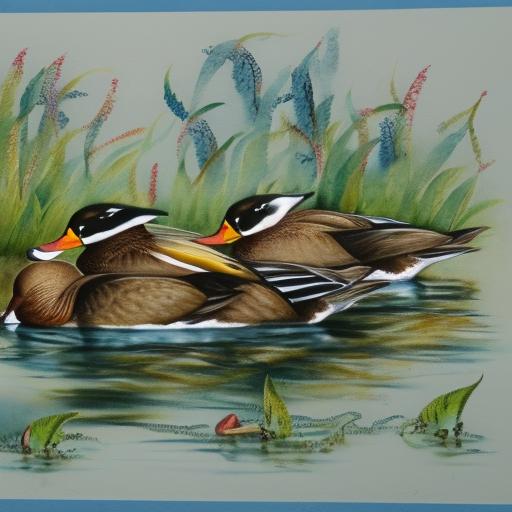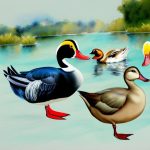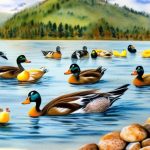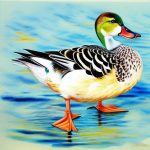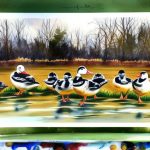The breeding season for ducks typically occurs in the spring and summer months, although the exact timing can vary depending on the species and geographic location. During this time, ducks engage in courtship behaviors, build nests, and lay eggs. The breeding season is a critical time for ducks as it is essential for the continuation of their species. Male ducks will often display elaborate courtship behaviors to attract females, including vocalizations, head bobbing, and wing flapping. Once a pair has formed, they will search for a suitable nesting site, typically near water, where the female will lay her eggs. The female will then incubate the eggs until they hatch, at which point the ducklings will be raised by both parents.
The breeding season is a time of heightened activity for ducks, as they must find suitable mates, build nests, and raise their young. This period is crucial for the survival of duck populations, as it ensures the next generation of ducks will be born and raised successfully. Understanding the breeding season for ducks is important for conservation efforts, as it allows researchers and wildlife managers to monitor populations and implement measures to protect nesting sites and ensure the survival of ducklings. By understanding the breeding season, we can better appreciate the natural behaviors of ducks and work to protect their habitats during this critical time.
Key Takeaways
- Duck breeding season typically occurs in the spring and early summer, with variations based on species and geographic location.
- Factors such as temperature, food availability, and daylight length influence the timing of duck breeding.
- Breeding season is crucial for maintaining healthy duck populations and ensuring the continuation of the species.
- Signs of the breeding season in ducks include courtship displays, nest building, and increased vocalization.
- Conservation efforts during duck breeding season include habitat protection, predator control, and public education to minimize disturbances.
- Human activities such as habitat destruction, pollution, and disturbance can negatively impact duck breeding success.
- When observing duck breeding season in the wild, maintain a respectful distance, avoid disturbing nests, and refrain from feeding or approaching ducks.
Factors influencing the timing of duck breeding
Several factors can influence the timing of duck breeding, including environmental conditions, food availability, and daylight hours. In general, ducks breed in the spring and summer months when temperatures are warmer and food sources are more abundant. The availability of suitable nesting sites and water sources also plays a significant role in determining when ducks will breed. Additionally, the length of daylight hours can trigger hormonal changes in ducks, signaling the start of the breeding season.
The timing of duck breeding can also be influenced by weather patterns and climate change. Warmer temperatures and earlier springs can cause ducks to begin breeding earlier in the year, while extreme weather events such as droughts or floods can disrupt nesting sites and impact breeding success. Human activities, such as habitat destruction and pollution, can also affect the timing of duck breeding by altering the availability of food and nesting sites. Understanding these factors is crucial for conservation efforts, as it allows researchers to predict when ducks will breed and implement measures to protect their habitats during this critical time.
The importance of breeding season for duck populations
The breeding season is of utmost importance for duck populations as it ensures the continuation of their species. During this time, ducks engage in courtship behaviors, build nests, lay eggs, and raise their young. The successful breeding season is essential for maintaining healthy duck populations and preserving biodiversity in wetland ecosystems. Duck populations rely on successful breeding seasons to replenish their numbers and ensure the survival of their species.
The breeding season also plays a crucial role in maintaining ecological balance in wetland habitats. Ducks are important seed dispersers and help control insect populations, making them essential for the health of wetland ecosystems. By understanding the importance of the breeding season for duck populations, we can work to protect their habitats and ensure their continued survival. Conservation efforts during the breeding season are essential for protecting nesting sites, managing water levels, and minimizing disturbances that could impact breeding success.
Signs of the breeding season in ducks
There are several signs that indicate the onset of the breeding season in ducks. One of the most noticeable signs is the display of courtship behaviors by male ducks. This can include vocalizations, head bobbing, wing flapping, and other elaborate displays to attract females. Once a pair has formed, they will often be seen together as they search for a suitable nesting site. Female ducks may also exhibit changes in behavior as they prepare to lay their eggs, such as increased time spent near water or searching for suitable nesting materials.
Another sign of the breeding season is the construction of nests by female ducks. Nests are typically built near water and are made from grasses, reeds, and other vegetation. Female ducks will spend a significant amount of time building their nests and lining them with down feathers to provide insulation for their eggs. Once the eggs are laid, the female will begin incubating them until they hatch. These signs of the breeding season are important for wildlife enthusiasts and researchers to observe, as they provide valuable insights into the natural behaviors of ducks and can help inform conservation efforts.
Conservation efforts during duck breeding season
Conservation efforts during the duck breeding season are crucial for protecting nesting sites and ensuring the survival of ducklings. One important conservation measure is the protection of wetland habitats, which are essential for ducks to breed successfully. Wetlands provide food, shelter, and nesting sites for ducks, making them critical for their survival during the breeding season. Conservation organizations work to protect wetlands through land acquisition, habitat restoration, and water management practices that benefit duck populations.
Another important conservation effort during the breeding season is minimizing disturbances that could impact nesting success. This includes restricting human activities near nesting sites, such as boating, fishing, and recreational activities that could disrupt nesting ducks. Conservation organizations also work to monitor duck populations during the breeding season to assess nesting success and implement measures to address any threats or challenges that may arise. By focusing on conservation efforts during the breeding season, we can help ensure the continued survival of duck populations and preserve their natural habitats for future generations.
Impact of human activities on duck breeding season
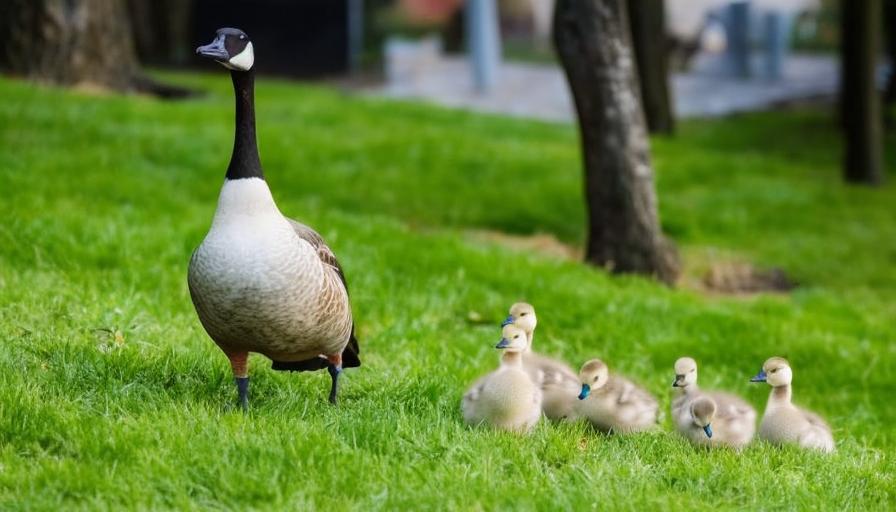
Human activities can have a significant impact on duck breeding season, posing threats to nesting sites and disrupting natural behaviors. Habitat destruction and degradation caused by urban development, agriculture, and pollution can reduce the availability of suitable nesting sites for ducks. Wetland drainage and water pollution can also impact food availability and water quality, which are essential for successful breeding.
Recreational activities such as boating, fishing, and hunting can disturb nesting ducks and cause them to abandon their nests, leading to reduced breeding success. Climate change can also impact duck breeding season by altering weather patterns and affecting food availability. By understanding the impact of human activities on duck breeding season, we can work to minimize disturbances and implement conservation measures to protect nesting sites and ensure the survival of duck populations.
Tips for observing duck breeding season in the wild
Observing duck breeding season in the wild can be a rewarding experience for wildlife enthusiasts and researchers alike. One tip for observing duck breeding season is to visit wetland habitats where ducks are known to breed. Look for signs of courtship behaviors such as vocalizations, head bobbing, and wing flapping by male ducks as they attract females. You may also observe pairs of ducks searching for suitable nesting sites near water.
Another tip is to bring binoculars or a spotting scope to observe nesting behaviors from a distance without disturbing the ducks. Look for female ducks building nests or incubating their eggs near water or in dense vegetation. It’s important to minimize disturbances during this sensitive time to ensure the success of duck breeding season. By following these tips, you can observe duck breeding season in the wild while respecting their natural behaviors and contributing valuable insights to conservation efforts.
If you’re wondering when the breeding season for ducks is, you might also be interested in learning about turning a shed into a chicken coop. This article from Poultry Wizard provides valuable insights and tips on transforming a shed into a comfortable and functional space for your chickens. Check out the article here to discover how you can create a cozy home for your feathered friends.
FAQs
What is the breeding season for ducks?
The breeding season for ducks typically occurs in the spring and summer months, varying by species and geographic location.
When do ducks start breeding?
Ducks generally start breeding in the spring, with some species beginning as early as February and others starting in April or May.
How long does the breeding season last for ducks?
The breeding season for ducks can last anywhere from a few weeks to several months, depending on the species and environmental conditions.
What factors influence the breeding season for ducks?
Factors that influence the breeding season for ducks include temperature, food availability, and the length of daylight hours.
Do all duck species have the same breeding season?
No, different duck species have varying breeding seasons based on their natural habitats and migratory patterns.
How do ducks choose their breeding partners?
Ducks often choose their breeding partners through courtship displays, vocalizations, and physical interactions. Males may also compete for the attention of females.
Where do ducks build their nests during the breeding season?
Ducks typically build their nests in secluded areas near water, such as marshes, ponds, or wetlands, to provide protection for their eggs and young.
Meet Walter, the feathered-friend fanatic of Florida! Nestled in the sunshine state, Walter struts through life with his feathered companions, clucking his way to happiness. With a coop that’s fancier than a five-star hotel, he’s the Don Juan of the chicken world. When he’s not teaching his hens to do the cha-cha, you’ll find him in a heated debate with his prized rooster, Sir Clucks-a-Lot. Walter’s poultry passion is no yolk; he’s the sunny-side-up guy you never knew you needed in your flock of friends!

